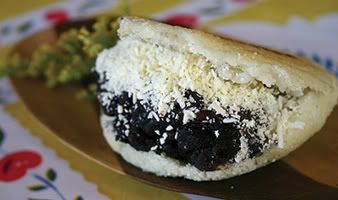I'm in a sunny island... near the beach, with my family... Is so hot, and the humidity is so intense, that I keep feeling like getting in the water, swim and then eat something like fish or so.
Yesterday I spent the day with my sister and my mom buying some things in a mall... You know how it is when you're shopping: You get hungry. We ended up in a sushi restaurant (Because I just love japanese food), and ordered this amazing soup. It was called "Chupe de Camarones", that means shrimps chupe. If you are a japanese food lover like me, you might say: "Hey!, wait a minute, that's not japanese", and you'd be right. This restaurant is a japanese-peruvian mix. Again you'd wonder how can that be. And I don't really have an accurate answer for you. But I do have some theories about that.
One of them is that many japanese ended up in Perú during War, settled up there and mixed their food (and I know this seems to be an copy paste from some previews entries, but I really think that people mix their food with local food when they migrate, I do). Another one is that the chef is from Peru, loved Japanese food, like I do, and just mixed that up with food he loved from his country. How or why he ended up in here, I have no idea, but I just love this tendency. And is not new, I bet you know about NOBU, and of course it's a mix from these two cultures and food. No mystery there, huh?.
Ok, so, we ordered this soup, and I was kind of waiting for some regular food, or maybe an Ok food. After all, is not common to find good sushi places in this island, but I was very surprised when I took the spoon to my mouth: It was perfect!. It had an exceptional flavor, it mixed spice, with a little bit of sweet, salty flavor, and of course, you could feel the shrimp in the broth and there were shrimps, but you could totally feel that kind of neutralized by cream and tiny chunks of white cheese. It hadn't a fishy flavor, it was a perfectly cooked, and perfectly Perfect soup... And I don't say that about everything I eat... not the word perfect...
It had this color that kept me thinking about what did they used to color it up...
I couldn't feel tomato in the soup, neither Onoto, that is a very used spice in my country to get things colored up... I had to talk to the chef, or the intrigue wouldn't let me sleep at night. It turns up that the used some kind of pepper (called Ají Panca), that is very common in Peru. The chef even told me where to find it, and how to use it, but I wouldn't dare to recommend that until I've tried it out before... And of course, I don't have the recipe of this Amazing Chupe, but if you ever come to Margarita, I highly recommend this place to you, is called Bushido, in Rattan Plaza. It is the most amazing Chupe you'll ever have!











